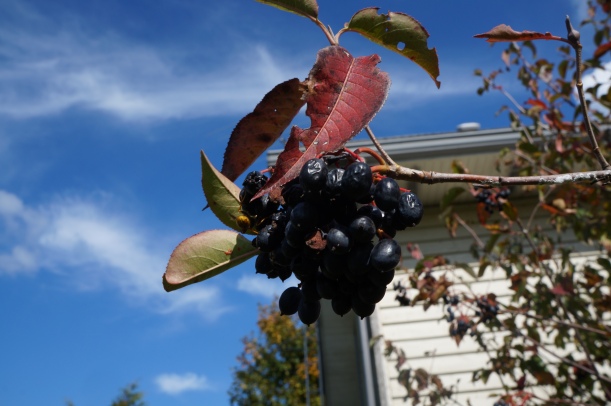Nannyberry (viburnum lentago), also known and sheepberry and sweet viburnum, is now ripe for picking. It is not yet a fruit which is widely recognized as being edible, but its sweet juicy berries and well-worth picking. Not only are they delicious, but they are easy to identify and very easy to pick. No prickly stems, no stooping, and the thick clusters of berries can just be pulled off in bunches, making them the most economical berries in terms of time. My little harvest took no more than 10 minutes (not counting the time spent nursing my bee sting). While I can’t vouch for just how nutritious they are, the deep black blue colour of the berries make me think they just have to be good for you.
Nannyberries are native to the northern US and southern Canada. It is often found along roadsides, near creeks and swamps, wherever there is a combination of water and sun. It is also cultivated because of its compactness, beautiful white clusters of flowers in late spring, bright foliage in the fall, hardiness in cold climates, and of course the dark clusters of berries which ripen towards the end of September through October. One thing I discovered is that the honey bees love them, so be careful when picking and where you plant them. However, if you keep bees, or you want to attract pollinators, the plants are a great acquisition.
To help you identify it, it has oval leaves growing in pairs on opposite sides of the twigs, slightly serrated edges, and narrowing to a point. At the tip of some branches, you will see a beak shaped growth.
The bark varies at different stages of the tree’s life – the younger ones are smooth with spots, and later those spots turn into vertical and horizontal cracks, giving the bark a rough surface. At this time of year, the twigs are red, and the bark of the trunk is a reddish grey. The fruit is a round blue back drupe (18-16 mm long) growing on clusters with reddish stems. They have one large, flat seed, which may be a deterrent to eating them directly off the plant. Therefore, I took the berries, cooked and strained them, making a sweet, dark sauce. The flavour is similar to that of prunes, and I think this sauce could be used in any recipe calling for pureed prunes or dates.
To prepare, cover the berries with water in a saucepan, and simmer until the berries seem very soft – about 10 min. Strain through a food mill or one of these. (Photo of straining wild grapes)
Return the pulp to the saucepan, and add about 1/2 cup sugar per 2 cups of pulp. Heat just to dissolve the sugar.
I used this sauce on some cornmeal pancakes as my contribution to this week’s Fiesta Friday, but there are many more uses I can think of: ketchup and dips, serve over cakes, in parfaits, puddings, and ice cream.






























